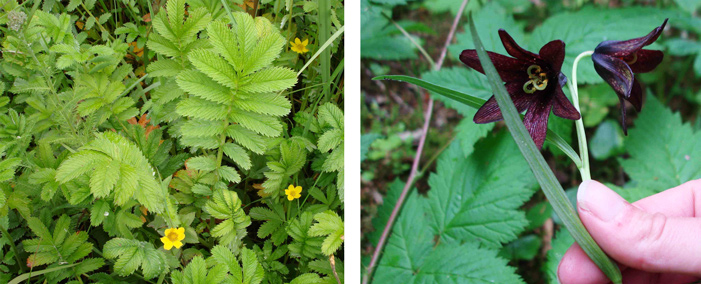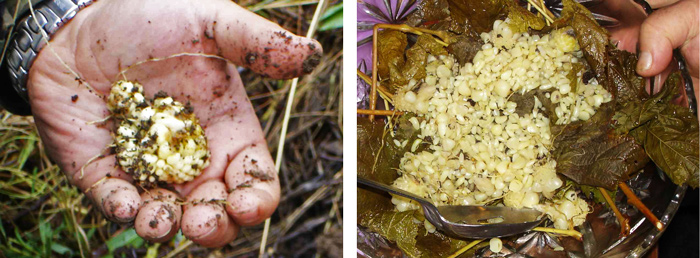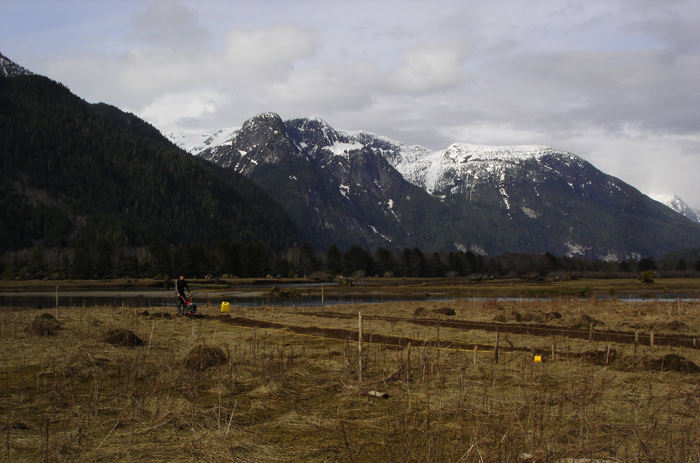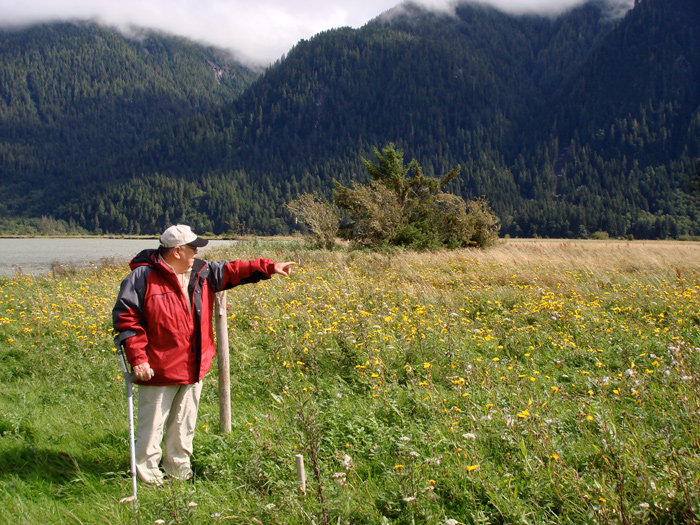Reviving an Ancient Agricultural Practice: The Root Gardens of Canada's West Coast Aboriginals
A prophesy was foretold in the early twentieth century by the Kwakwaka’wakw people of British Columbia, that the Canadian government would in time no longer suppress indigenous ways of life. Aboriginal culture would one day flourish again, the way it did before European colonization.
In 1929 the Kwakwaka’wakw people chose Clan Chief Adam Dick, or Kwaxsistalla as he is known by his own people, as one of the children who would act as a storehouse for aboriginal cultural, ecological, and historical knowledge. These children were helped by the tribe to secretly evade the government’s crackdown on indigenous ways of life.
One of the traditional practices Chief Dick recalls is the type of specialized agriculture done in root gardens along the west coast of North America known as t’ekilakw, or “places of man-made soil.†T’ekilakw is a system of perennial root gardens constructed along coastal estuaries using natural inputs from the sea. Due to governmental, intellectual, and societal repression of indigenous lifestyles, these root gardens had all but been forgotten or actively covered up until only a few years ago. The unearthing of what may seem to be a minor discovery could have profound cultural and even political ramifications.
The Discovery
In the mid-1990s, Dr. Douglas Deur of Portland State University theorized that Native Canadians along the coast of British Columbia had manipulated the land in ways conducive to food production. His research found that the gardens were designed to capture debris brought by tidal waves, such as dead fish, kelp, and other nutrients. These inputs nurtured the perennial roots of species such as Potentilla anserina ssp. pacifica (Pacific silverweed), Trifolium wormskioldii (springbank clover) and Fritillaria camschatcensis (rice-root).

Initially there was opposition towards Dr. Deur’s research. Some anthropologists wanted to sweep the existence of the root gardens under the rug because they poke a hole in long-held anthropologic theory. Some scholars like to believe that the indigenous peoples of North America are an anomaly to the idea that advanced agriculture is a precursor to civilization. It has long been believed that aboriginals do not follow this trend; they have a well-developed culture without tilling the soil. The existence of the root gardens challenges this belief and unravels the story anthropologists have woven around indigenous groups.
However, over the course of ten years, Dr. Deur and other scholars defended the discovery of the gardens and it is now accepted as what has been described as the “new orthodoxy.†But acknowledging an ancient agricultural practice wasn’t Dr. Deur’s only motivation for pursuing the research. “I got into this knowing that it would result in a re-evaluation of land claims and that was one of several incentives to do it,†he said. Providing compelling evidence that West Coast aboriginals cultivated the land strengthens claims that chiefs have made for many years, that their people have a connection to the land which is integral to their way of life.

Tilling the soil
Ethnobotanist, Dr. Nancy Turner of the University of Victoria has worked with graduate students in the root gardens and has written a book with Dr. Deur called “Keeping it Living.†She, along with the help and input of aboriginal elders, created a model t’ekilakw on British Columbia’s mainland coast. The purpose of the project was to reduce the local community’s reliance on imported food and to ensure the survival of this traditional knowledge, which she postulates dates back a thousand years. “[The elders are] anxious to have the children and young adults learn about these roots, to taste them, to understand their role in the culture,†Dr. Turner said.
Restoring the coastal soil to a perennial root garden wasn’t easy work. Traditionally, West Coast aboriginals used specialized digging sticks to aerate the soil. However, introduced grasses and cattle from Europe had compacted the land into a clayish sod. Dr. Turner and her students had to use a rototiller to break up the clay and reveal the fertile loam under the surface.
 The types of plants cultivated in Dr. Turner’s and traditional t’ekilakw gardens are known as halophytes (plants which grow well in salty, brackish water). Dr. Turner finds the root gardens important because they show that river estuaries, which are traditionally used as industrial wastelands, can be productive agricultural sites. Moreover, t’ekilakw are good examples that farming can be done by working with natural systems rather than against them. Constructing artificial environments, such as clearing a forest to create open pasture, is known to be unsustainable. But, capitalizing on natural processes like tides and salmon runs could be done perpetually.
The types of plants cultivated in Dr. Turner’s and traditional t’ekilakw gardens are known as halophytes (plants which grow well in salty, brackish water). Dr. Turner finds the root gardens important because they show that river estuaries, which are traditionally used as industrial wastelands, can be productive agricultural sites. Moreover, t’ekilakw are good examples that farming can be done by working with natural systems rather than against them. Constructing artificial environments, such as clearing a forest to create open pasture, is known to be unsustainable. But, capitalizing on natural processes like tides and salmon runs could be done perpetually.
Dr. Turner believes that this type of sustainable agriculture could potentially change the way we produce food on a large scale. “The idea of permaculture is kind of derived from these agro-ecology systems from different parts of the world, and permaculture has been taken quite seriously in terms of the contribution it can make to world food production.â€
Bringing it all back home
The repatriation of root gardening to North America’s West Coast is still in its infantile stages. However, aboriginal leaders, such as Dr. E. Richard Atleo of the Centre for Indigenous Environmental Resources, are encouraging its spread. Dr. Atleo grew up near Vancouver Island’s eastern shore and became the first aboriginal to receive a doctorate degree from the University of British Columbia. He thinks the root gardens can have a positive transformative effect on aboriginals’ lives through nutrition as well as politics.
Dr. Atleo spoke of how European scholars rewrote indigenous history in an attempt to erase the aboriginal’s past and alter their cultural ways. This resulted in a multitude of negative consequences; one being unhealthy diets. “We were encouraged to do away with our traditional diets and eat whatever was brought in,†he said. “Vegetables were removed from our traditional diets and one of the consequences of this is diabetes.â€
Health Canada reports that First Nations and Inuit peoples have a three to five times higher diabetes rate than other Canadians. Dr. Atleo thinks that the reintroduction of vegetables into indigenous communities’ diets can not only help combat diabetes, it can also help alleviate other social ills. “When you don’t have a healthy diet, you have depression and suicide as indirect consequences,†he said. “Alcohol and drugs give a sense of well-being that is temporary, but nutrition does the same thing [more permanently]. Good nutrition brings about a sense of well-being which mitigates against alcohol, drugs and other abusive ways of life.â€
Politically, Dr. Atleo thinks that the discovery of the root gardens could help support West Coast aboriginal land claims, but a lot of work is still needed to prove it. “Its [an] area of change, of confusion, of ambiguity, a lot of misunderstanding, but the change is towards a greater acceptance of the indigenous presence with an indigenous voice,†he said. “It’s still in a stage of emergence, and with anything emergent, it will take multiple kinds of interpretations.â€
Dr. Atleo is currently looking for additional aboriginal graduate students to help build more than just a model t’ekilakw. Unfortunately, his past attempts to build more gardens have been stifled by his students’inability to dedicate enough time and effort to the project. He feels that aboriginal students are more likely to have a vested interest in reviving the gardens as a part of everyday life.
Although the root gardens may initially seem to be a minor anthropological detail, they may just play a part in fulfilling Clan Chief Adam Dick’s prophesy.

Photo credits: Top four, courtesy of Nancy Turner; middle, courtesy of T. Abe Lloyd; bottom, courtesy of Clan Chief Adam Dick.

